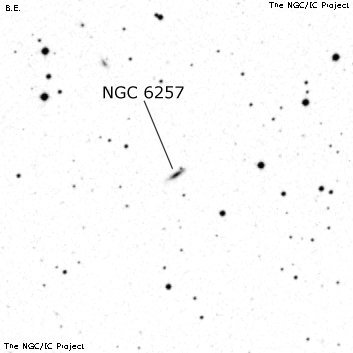NGC/IC Project Restoration Effort
(This is a very very beta version)
NGC6257


Basic Information
Location and Magnitude
Right Ascension: 16:54:52.2
Declination: +39:36:50
Constellation: HER
Visual Magnitude:
Historic Information
Discoverer: Herschel J.
Year of discovery: 1831
Discovery aperture: 18.3
Observational
Summary description: vF (vS D * ?), F D * nf
Sub-type: NF
Corwin's Notes
=====
NGC 6257. Steve Gottlieb points out that there is no trace of this object
near JH's position. However, just 1 minute of time west, and 9 arcminutes
north, is the radio galaxy 4C +39.49 = CGCG 225-007 = UGC 10599. Is this JH's
object, perhaps with digit errors in the RA and Dec?
I dug into this and sent this to Steve.
I just looked at the sweep [16 May 1831, in the Herschel Archives] where
NGC 6257 = h 1974 is No. 37, and see that JH's reduced position is the same
as his published position -- no transcription error. It fits into RA order
with the other objects in the sweep, too. [The declination is also
consistent with the rest of the sweep.]
There are a few problems with other objects in the sweep. No. 34 has no RA
recorded, and No. 38 has only an illegible note, with no RA or Dec recorded.
There are several other objects earlier in the sweep with either very
approximate positions recorded, or with corrected reduced positions. Those
kinds of entries seem to be relatively common in the record books, though,
so I'm not willing to say that there are unusual errors in this particular
sweep.
Unfortunately, the unreduced observation of No. 37 on the left page, and all
[of JH's] comments there, are almost illegible. From what I can make out,
though, there is nothing to suggest a large reduction error. The unreduced
observation looks something like "[16] 49 50[?] -14[?]" in the RA column and
"2 5 13" in the Dec column. Checking other objects in the sweep, these are
consistent with what I can make out from the reduced positions and the
observations that are clear enough to read.
I'll peer at them some more, but suspect that unless you or Wolfgang can
make more of the faint writing than I can, we'll have to go to the RAS to
ask if they can read the original with any more certainty.
You are quite right that the usual galaxy CGCG 225-012 doesn't match JH's
published description at all. So, I looked at the field and found a galaxy,
UGC 10599, that has aroused my suspicions. It is just one minute of time
west of JH's RA, and 9 arcmin north of his Dec -- digit errors?
But from there, it gets murky. As you noted, JH says "It is pointed to by a
F double * nf." A faint double star pointing at the galaxy is indeed on the
sky, but is *south* following, not north.
The possible identification falls apart pretty completely as we read the
rest of JH's description: "Doubtful whether a nebula or a vF double star,
with perhaps a third star near (of course ill seen)." There is no way that
I can make UGC 10599 fit that description. The galaxy is Markarian 501, a
UV-excess galaxy; and is also 4C +39.49, one of the radio galaxies that
helps define the basic astrometric reference system in use today, the ICRF.
I looked at the galaxy in several optical and infrared images, and there is
no trace of the duplicity that JH suspected, nor is there a third star near
enough that might have caught his attention. The nucleus sits nearly alone
on the sky with only some faint stars and much fainter galaxies nearby. It
is bright enough that JH could have seen it, but the neighbors on the sky
are too faint.
So, I don't think this is his object, but I've included it as another
possibility.
Steve has this to say about CGCG 225-012:
RNGC, CGCG and PGC identify CGCG 225-012 as NGC 6257, though this galaxy is
70 seconds of RA east of Herschel's position (and 2' north). I don't see a
reasonably bright "faint double star nf" matching his description. In
addition, I question whether this galaxy is bright enough to have picked up
by JH. Although I was able to see it in my 17.5-inch a number of years
ago, it required averted vision and knowing the exact location beforehand to
glimpse it. Karl Reinmuth was probably the first to equate CGCG 225-012
with NGC 6257, though his position is 2.5' too far southwest.
So, we are left with question marks and no clear identification.
Steve's Notes
=====
NGC 6257
17.5" (6/24/95): extremely faint, very small, round, 15" diameter (elongated NW-SE on the POSS). Requires averted vision but sighting certain using GSC field chart. A mag 13 star is 1.7' SW (part of collinear string of stars oriented NW-SE). Uncertain RNGC identification.
17.5": not seen in fairly poor seeing and transparency.



